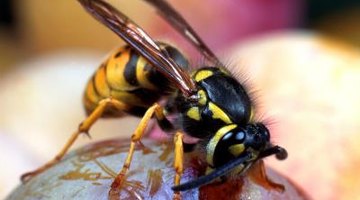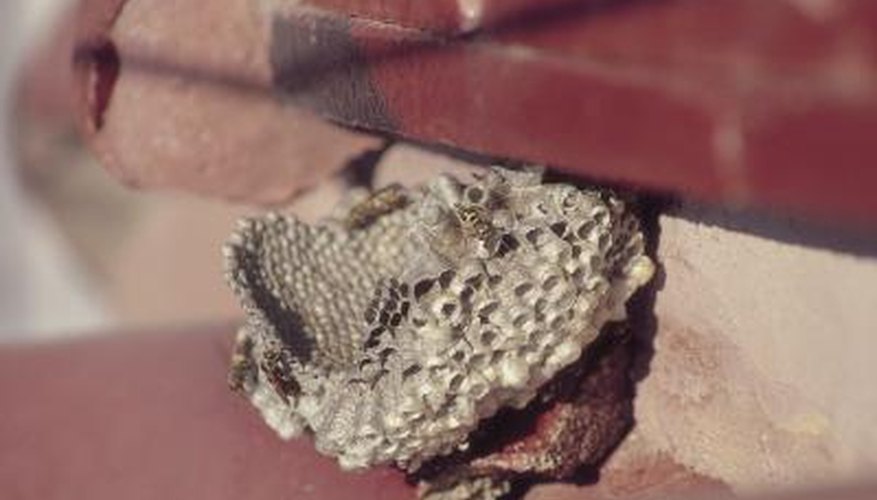While wasps commonly build their nests under the eaves of a roof or slip beneath shingles and cracks to enter the attic, they don't usually leave any damage behind. A colony of wasps will take advantage of cracking or splitting wood to slip inside, but the presence of a colony often means damage was already there. Repairing this damage is crucial to ensuring no more infestations occur.
Roof-Dwelling Wasps
Under the eaves of the roof is a popular nesting spot for several types of wasps, including paper wasps and yellowjackets. They attach their papery, ball-shaped nests to the underside of the overhangs of roofs, but the nests cause no damage. After the colony scatters and abandons the site in autumn, you can break off the nest and wipe away any remnants. In many cases, the nest leaves no visible traces. If an abandoned wasp nest is too high for you to remove, simply leave it and nature will demolish it in due course. Wasps do not reuse old nests.
- Under the eaves of the roof is a popular nesting spot for several types of wasps, including paper wasps and yellowjackets.
- After the colony scatters and abandons the site in autumn, you can break off the nest and wipe away any remnants.
Getting Inside
Wasps such as paper wasps and yellowjackets commonly nest in attics and in wall voids inside the home. One of the ways they get inside is through tiny gaps or holes that may not be readily visible from the outside. Roof damage can make the interior of the home vulnerable. Weather-worn shingles can allow moisture to get inside, warping boards and providing an entry for wasps. If wasps have set up a nest inside, check the roof for signs of damage. Watching the wasps come and go will give you an idea where to look for their entry point. Once inside, wasps can build extensive nests that generally do not damage the structure but can be difficult to get rid of.
- Wasps such as paper wasps and yellowjackets commonly nest in attics and in wall voids inside the home.
- Weather-worn shingles can allow moisture to get inside, warping boards and providing an entry for wasps.
Prevention

If you have wasps entering your home through cracks or gaps in the roof, seal off any entrance points you see. Carefully check other areas of the roof for similar damage. It may be necessary to replace boards or shingles, although you can caulk some cracks. If the damage seems extensive, consult a professional. For nests that have been built under the eaves, use a pesticide developed for wasps and apply it in the evening hours. Once there is no more activity around the nest, place a garbage bag over the nest and break it off where it is attached. This will generally remove the entire nest; if there are pieces left behind, clean them off with a scrub brush and cleaner.
- If you have wasps entering your home through cracks or gaps in the roof, seal off any entrance points you see.
- Once there is no more activity around the nest, place a garbage bag over the nest and break it off where it is attached.
Roof Damage from Insects

There are nesting insects that can do damage to roofs, and these nests will need to be removed completely to prevent ongoing damage. Social bees like the honeybee are highly beneficial, and having a nest near the garden will ensure pollination and a bumper crop of flowers. They are generally less aggressive than wasps and easily mistaken for them. Although they will defend their nests, their role in the environment is a generally beneficial one. The nests bees build are filled with wax and honey. When these nests are left in the roof through the summer months, they can melt in this typically hot part of the house. Melting honeycombs and wax will not only cause a sticky mess on the roof but they will also attract other pests, from wasps and ants to rodents that can cause further damage.
- There are nesting insects that can do damage to roofs, and these nests will need to be removed completely to prevent ongoing damage.
